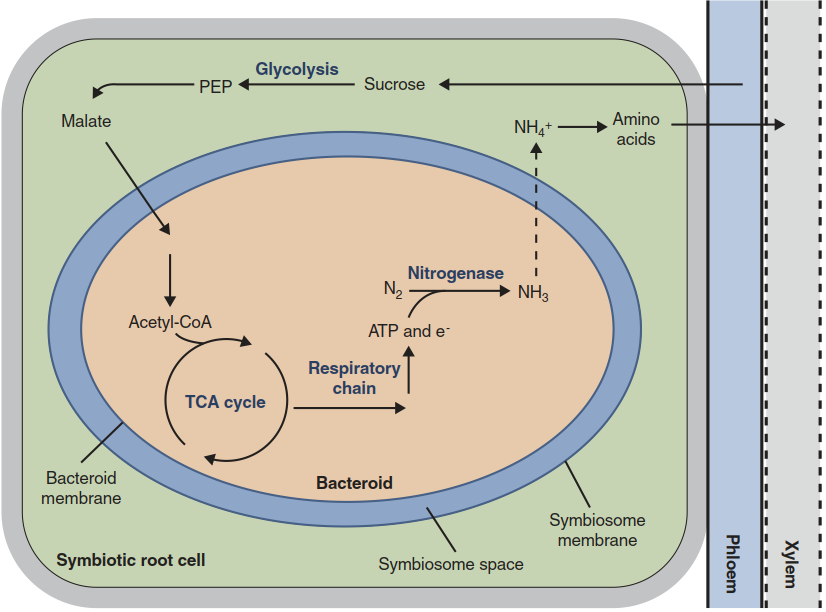Nitrogen Fixation
Biological nitrogen fixation represents the major route of nitrogen supply to plants in natural terrestrial environments (an estimated 80-90%), while input into agricultural ecosystems originates largely from industrial production of NH3 through the Haber-Bosch process. The conversion of inert atmospheric N2 into organic nitrogen is of utmost importance for the global N cycle. The enrichment of soils with nitrogen has a massive impact on ecosystems.
A limited number of bacteria are able to fix atmospheric N2 to NH3. These bacteria are either free-living in the soil, associated with plants or partners in a symbiosis with plants. Those quantitatively most important with respect to the total nitrogen supplied to plants are symbiotic N2 fixers. They account for approximately 80% of the biologically fixed nitrogen.
Different types of nitrogen-fixing symbioses exist:
- Fabaceae establish symbioses with bacteria of the genus Rhizobium
- Woody shrubs and trees (e.g. Alnus) live in symbiosis with actinomycetes (Frankia)
- Diverse plant species such as certain gymnosperms or the fern Azolla host cyanobacteria
Molecularly the Fabaceae-rhizobia symbiosis is the best-understood symbiosis and will therefore be the focus here.
The symbiotic bacteria live in specialised structures (nodules in the case of the Fabaceae- rhizobia symbiosis) within the plant host. These provide suitable conditions for the supply of reduced carbon to the bacteria and the transfer of fixed nitrogen to the host. Another essential requirement is protection of the feature enzyme of all N2-fixing bacteria—nitrogenase—from oxygen. Nitrogenase catalyses the reaction:

It is immediately clear how energy demanding the nitrogenase reaction is. This probably explains why symbiotic N2 fixation has such a dominant role in nature. For free-living bacteria it is extremely difficult to provide the ATP needed for NH3 production. In contrast, symbiotic bacteria are supplied with assimilates by the host. The oxidation through respiration produces enough ATP to ensure efficient nitrogen fixation. A major challenge is the co-occurrence of respiration and oxygen-sensitive nitrogenase reaction. The mechanisms involved in generating a low-oxygen atmosphere in the vicinity of the nitrogenase are a bacterial cytochrome oxidase with an unusually high O2 affinity and the synthesis of O2-binding leghemoglobins by the host cells.
Within root nodule cells, rhizobia live as bacteroids in a specialised structure, the symbiosome (Fig. 7.22). The symbiosome is separated from the cytosol of the nodule cell by a membrane. Carbohydrates arriving at nodules via the phloem are converted into organic acids.

Fig. 7.22. A symbiosome within a nodule cell. The plant- derived symbiosome membrane encloses the bacteroid, a symbiotic form of a rhizobacterium. Exchange of nutrients and metabolites between the cytosol of the nodule cell and the bacteroid occurs across the symbiosome and the bacteroid membrane. The plant cell supplies organic acids such as malate to the bacteroid. Oxidation of these organic acids provides the energy for the N2-fixing nitrogenase reaction. Ammonia is assimilated via glutamine into amino acids, which are then exported
One fraction of these is taken up by the bacteroids, where they are oxidised in the citric acid cycle (alternatively called the TCA cycle). ATP and reducing equivalents are then used for the nitrogenase reaction. The resulting NH4+ is assimilated into glutamine in the cytosol of the nodule cell. The other fraction of the organic acids provides the carbon skeletons for the nitrogen export compounds. Depending on the host plant, either glutamine itself can be exported or it can serve as an amide donor for other metabolites (asparagine, allantoin) supplying organic nitrogen to tissues outside the nodules.
Date added: 2025-01-27; views: 243;
